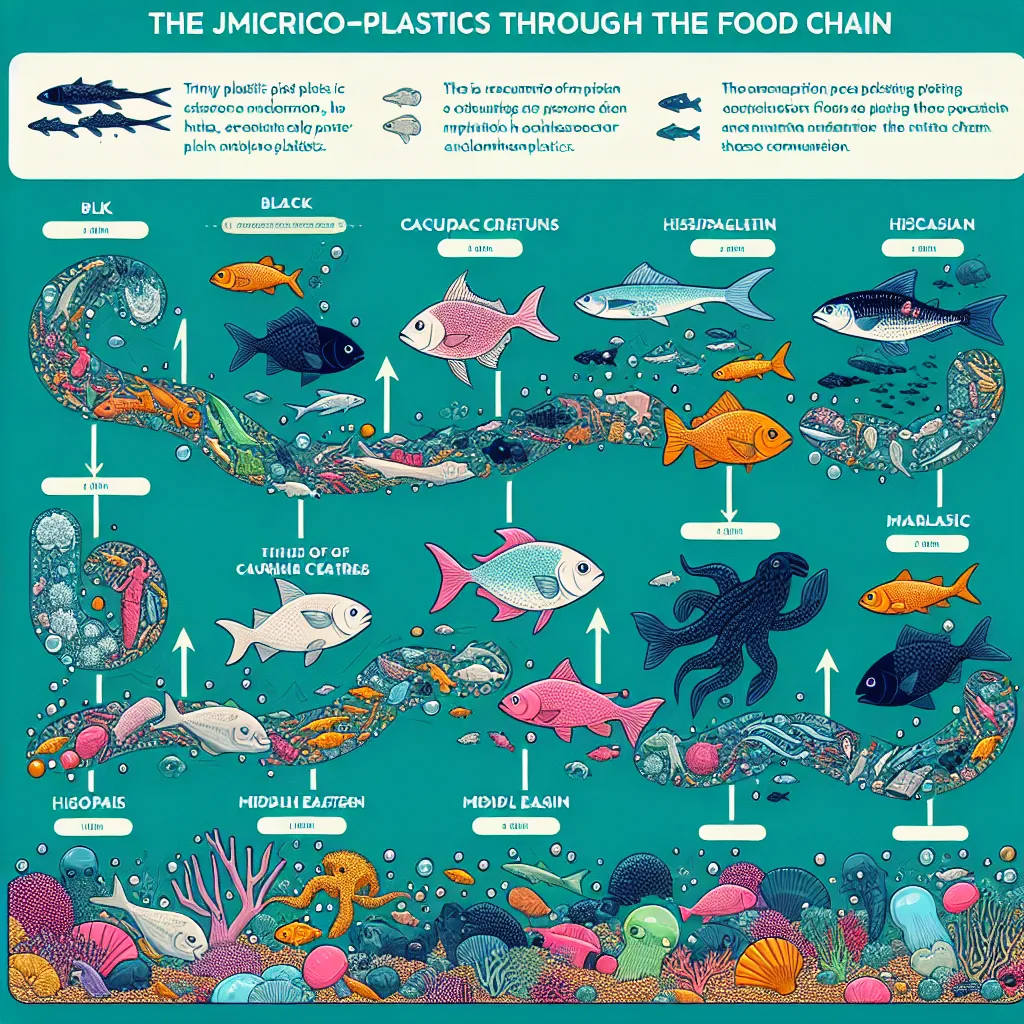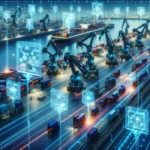Welcome to our IELTS Reading practice session focusing on the crucial environmental topic of microplastics and their impact on food chains. As an experienced IELTS instructor, I’ve crafted this comprehensive practice test to help you enhance your reading skills while gaining valuable knowledge about this pressing ecological issue.
 Microplastics in Food Chain
Microplastics in Food Chain
Introduction to the Topic
The impact of microplastics on food chains is a growing concern in environmental science. As plastic pollution continues to escalate, these tiny particles are finding their way into our ecosystems, affecting marine life, terrestrial animals, and ultimately, human health. This IELTS Reading practice will not only test your comprehension skills but also provide you with essential information about this critical environmental issue.
IELTS Reading Test Structure
Before we dive into the practice test, let’s quickly review the structure of the IELTS Reading test:
- The test consists of three passages of increasing difficulty.
- You will have 60 minutes to complete all three sections.
- Each section contains 13-14 questions, for a total of 40 questions.
- The passages cover a range of topics and may include graphs, diagrams, or illustrations.
Now, let’s begin with our practice test on the impact of microplastics on food chains.
Passage 1 (Easy Text)
The Growing Concern of Microplastics
Microplastics, tiny plastic particles less than 5 millimeters in size, have become a ubiquitous presence in our environment. These minuscule fragments originate from various sources, including the breakdown of larger plastic items, microbeads in personal care products, and synthetic fibers from clothing. As plastic production and consumption continue to rise globally, the proliferation of microplastics in our ecosystems has become an escalating concern for scientists and environmentalists alike.
The pervasive nature of microplastics means they can be found in virtually every environment on Earth, from the deepest ocean trenches to the highest mountain peaks. In aquatic environments, these particles are easily ingested by marine organisms, ranging from plankton to large fish. On land, microplastics contaminate soil and freshwater systems, affecting terrestrial ecosystems and potentially entering the human food supply through agricultural products.
One of the most alarming aspects of microplastic pollution is its potential to bioaccumulate in food chains. As smaller organisms consume microplastics, these particles can be passed up the food chain to larger predators, potentially concentrating in higher trophic levels. This process raises concerns about the long-term effects on ecosystem health and the potential risks to human consumers at the top of many food chains.
Research has shown that microplastics can cause physical harm to organisms, such as blockages in digestive systems or damage to organs. Additionally, these particles can adsorb and concentrate toxic chemicals from the surrounding environment, potentially acting as vectors for harmful substances throughout the food web.
As awareness of the microplastic issue grows, efforts to address the problem are increasing. These include initiatives to reduce plastic use, improve waste management systems, and develop new technologies for removing microplastics from the environment. However, given the persistent nature of plastics, addressing this global challenge will require sustained effort and international cooperation.
Questions 1-6
Do the following statements agree with the information given in the passage? Write
TRUE if the statement agrees with the information
FALSE if the statement contradicts the information
NOT GIVEN if there is no information on this
- Microplastics are plastic particles larger than 5 millimeters in size.
- Synthetic fibers from clothing are a source of microplastics.
- Microplastics can be found in both marine and terrestrial environments.
- All marine animals are equally affected by microplastic ingestion.
- Microplastics can accumulate toxic chemicals from their surroundings.
- There is a global consensus on how to solve the microplastic pollution problem.
Questions 7-8
Choose the correct letter, A, B, C, or D.
-
The term “bioaccumulate” in the passage suggests that microplastics:
A) dissolve in water over time
B) increase in concentration up the food chain
C) multiply rapidly in marine environments
D) change their chemical composition in organisms -
According to the passage, which of the following is NOT mentioned as an effort to address the microplastic problem?
A) Reducing plastic use
B) Improving waste management
C) Developing new removal technologies
D) Banning all plastic production
Passage 2 (Medium Text)
Microplastics in Marine Food Webs
The infiltration of microplastics into marine ecosystems represents one of the most pervasive and insidious forms of pollution facing our oceans today. These minute plastic particles, often invisible to the naked eye, have been detected in every corner of the world’s seas, from the surface waters to the deepest trenches. The ubiquity of microplastics in marine environments has raised significant concerns about their impact on marine food webs and, by extension, the potential consequences for human health.
Marine food webs are intricate and delicate systems, with energy and nutrients flowing from primary producers like phytoplankton through various trophic levels to top predators. The introduction of microplastics into this system has the potential to disrupt these carefully balanced relationships. Research has shown that microplastics are readily ingested by a wide range of marine organisms, from the smallest zooplankton to large filter feeders like whales.
One of the most concerning aspects of microplastic pollution in marine food webs is the phenomenon of trophic transfer. This process occurs when microplastics are passed from prey to predator, potentially leading to biomagnification – the increasing concentration of contaminants at higher trophic levels. Studies have demonstrated that microplastics ingested by zooplankton can be transferred to small fish that feed on them, and subsequently to larger predatory fish. This transfer up the food chain raises the possibility of microplastics accumulating in commercially important fish species that are consumed by humans.
The physical presence of microplastics in marine organisms can cause a range of detrimental effects. In some cases, the ingestion of microplastics can lead to physical blockages or damage to the digestive system, potentially reducing feeding capacity and overall fitness. Moreover, there is evidence to suggest that the presence of microplastics in the gut can alter nutrient uptake and energy allocation in affected organisms.
Beyond the physical impacts, microplastics pose a chemical threat to marine food webs. These particles have been shown to adsorb and concentrate various environmental pollutants, including persistent organic pollutants (POPs) and heavy metals. When ingested, these contaminated microplastics can potentially release their toxic payload into the organisms’ tissues. This chemical transfer not only affects the immediate consumer but also has the potential to biomagnify up the food chain, potentially reaching humans who consume seafood.
The implications of microplastics in marine food webs extend beyond individual organisms to ecosystem-level effects. By altering the health and behavior of key species at various trophic levels, microplastics have the potential to disrupt ecological relationships and food web dynamics. For example, if microplastic ingestion reduces the fitness of a crucial prey species, it could have cascading effects throughout the ecosystem.
Addressing the issue of microplastics in marine food webs requires a multi-faceted approach. Efforts to reduce plastic pollution at its source through improved waste management and the development of biodegradable alternatives are crucial. Additionally, research into methods for removing microplastics from marine environments is ongoing, although the scale of the problem makes complete removal a daunting task.
As our understanding of the impacts of microplastics on marine food webs continues to grow, it becomes increasingly clear that this is not just an environmental issue, but one that has direct implications for human health and food security. The interconnectedness of marine ecosystems with human societies underscores the urgency of addressing this global pollution crisis.
Questions 9-13
Complete the summary below.
Choose NO MORE THAN TWO WORDS from the passage for each answer.
Microplastics have become a major concern in marine ecosystems, affecting food webs from primary producers to top predators. The process of 9)__ can lead to an increased concentration of microplastics at higher levels of the food chain. Ingestion of microplastics can cause 10)__ in marine organisms, affecting their ability to feed and overall health. Additionally, microplastics can absorb and concentrate 11)__, posing a chemical threat to marine life. The presence of microplastics in marine food webs can have 12)__ effects, potentially disrupting entire ecosystems. Addressing this issue requires efforts to reduce pollution and develop 13)__ alternatives to conventional plastics.
Questions 14-18
Choose FIVE letters, A-H.
Which FIVE of the following statements are true, according to the passage?
A) Microplastics have been found in all parts of the world’s oceans.
B) Only large marine animals are affected by microplastic pollution.
C) Trophic transfer of microplastics can lead to their accumulation in commercially important fish.
D) Microplastics always cause immediate death in marine organisms that ingest them.
E) The presence of microplastics in an organism’s gut can affect its nutrient uptake.
F) Microplastics can concentrate environmental pollutants on their surface.
G) The effects of microplastics are limited to individual organisms and do not impact entire ecosystems.
H) Addressing microplastic pollution requires a multi-faceted approach.
Passage 3 (Hard Text)
The Hidden Threat: Microplastics in Terrestrial Food Chains
While the impact of microplastics on marine ecosystems has garnered significant attention, their presence and effects in terrestrial environments have been comparatively understudied. However, emerging research suggests that the pervasiveness of microplastics in land-based ecosystems may be equally alarming, with potentially far-reaching consequences for terrestrial food chains and, ultimately, human health.
Microplastics find their way into terrestrial ecosystems through various pathways. The application of sewage sludge as fertilizer, the breakdown of plastic mulches used in agriculture, and the deposition of airborne microplastics are all significant contributors. Once in the soil, these particles can persist for extended periods, interacting with soil biota and potentially entering the food chain through plant uptake or direct ingestion by soil-dwelling organisms.
The intricate web of terrestrial food chains provides numerous opportunities for microplastics to move through trophic levels. Soil invertebrates, such as earthworms and springtails, which form the base of many terrestrial food webs, have been shown to ingest microplastics. These particles can then be transferred to higher-order consumers, including birds, small mammals, and eventually, apex predators. The potential for bioaccumulation and biomagnification of microplastics and associated contaminants in terrestrial systems mirrors concerns observed in aquatic environments.
One particularly concerning aspect of microplastics in terrestrial food chains is their potential interaction with agricultural systems. Studies have demonstrated that crop plants can absorb nanoplastics through their root systems, translocating these particles to above-ground tissues. This uptake raises questions about the potential contamination of food crops and the implications for human consumption. Furthermore, the presence of microplastics in soil has been shown to alter soil structure and microbial communities, potentially impacting soil fertility and crop yields.
The effects of microplastics on terrestrial organisms are multifaceted and not yet fully understood. Physical impacts, such as gut blockage and tissue abrasion, have been observed in soil-dwelling invertebrates. However, the subtle and chronic effects of long-term exposure to low concentrations of microplastics may be more insidious. Changes in feeding behavior, reproductive output, and overall fitness have been reported in various terrestrial species exposed to microplastics.
Chemical interactions between microplastics and terrestrial ecosystems add another layer of complexity to the issue. Like their counterparts in aquatic environments, terrestrial microplastics can adsorb and concentrate environmental pollutants. The sorption of agrochemicals, such as pesticides and herbicides, onto microplastics is of particular concern, as it may alter the mobility and bioavailability of these substances in soil ecosystems.
The potential for microplastics to facilitate the spread of pathogens and antibiotic-resistant bacteria in terrestrial environments is an emerging area of research. Microplastics can serve as vectors for harmful microorganisms, potentially enhancing their survival and dispersal in soil systems. This phenomenon could have implications for soil health, plant pathogens, and potentially, human health through the contamination of food crops.
Addressing the issue of microplastics in terrestrial food chains presents unique challenges. Unlike in marine environments, where large-scale cleanup efforts can be implemented, removing microplastics from soil systems is extremely difficult and potentially disruptive to soil ecosystems. Prevention, therefore, becomes paramount. Strategies to reduce microplastic inputs into terrestrial environments include improving waste management practices, developing truly biodegradable plastics, and reconsidering the use of plastic-containing products in agriculture.
The study of microplastics in terrestrial food chains is still in its infancy, and many questions remain unanswered. Long-term studies are needed to fully understand the fate and behavior of microplastics in soil systems and their movement through terrestrial food webs. Additionally, research into the potential human health impacts of consuming food products contaminated with microplastics is crucial.
As our understanding of the issue grows, it becomes increasingly clear that the problem of microplastic pollution is not confined to our oceans but is a truly global phenomenon affecting all ecosystems. The interconnectedness of terrestrial and aquatic systems means that addressing this issue requires a holistic approach, considering the full life cycle of plastics and their impacts across all environmental compartments.
The presence of microplastics in terrestrial food chains represents a hidden threat with potentially far-reaching consequences. As research in this field progresses, it is likely to reveal further complexities and challenges. Addressing this issue will require concerted efforts from scientists, policymakers, industry leaders, and the public to develop innovative solutions and change our relationship with plastic materials.
Questions 19-23
Complete the sentences below.
Choose NO MORE THAN THREE WORDS from the passage for each answer.
-
Microplastics enter terrestrial ecosystems through various means, including the use of __ as fertilizer.
-
The uptake of nanoplastics by crop plants raises concerns about the potential __ of food crops.
-
Long-term exposure to low concentrations of microplastics may have __ effects on terrestrial species.
-
Microplastics in soil can adsorb __, potentially altering their behavior in ecosystems.
-
Unlike in marine environments, removing microplastics from soil is __ and could harm soil ecosystems.
Questions 24-26
Choose the correct letter, A, B, C, or D.
-
According to the passage, which of the following is NOT mentioned as a way microplastics enter terrestrial ecosystems?
A) Through sewage sludge used as fertilizer
B) From the breakdown of plastic mulches
C) Via airborne deposition
D) Through irrigation with contaminated water -
The passage suggests that microplastics in soil can:
A) Always improve soil fertility
B) Have no effect on soil microbial communities
C) Alter soil structure
D) Increase crop yields consistently -
Research into microplastics as vectors for pathogens suggests that they may:
A) Always reduce the survival of bacteria in soil
B) Enhance the dispersal of harmful microorganisms
C) Have no impact on soil health
D) Eliminate all plant pathogens
Questions 27-30
Do the following statements agree with the information given in the passage? Write
YES if the statement agrees with the views of the writer
NO if the statement contradicts the views of the writer
NOT GIVEN if it is impossible to say what the writer thinks about this
-
The effects of microplastics on terrestrial food chains have been studied as extensively as their effects on marine ecosystems.
-
Microplastics can be absorbed by plants and transported to their above-ground tissues.
-
The issue of microplastics in terrestrial environments can be easily solved with current technology.
-
Long-term studies are necessary to fully understand the impact of microplastics on terrestrial food webs.
Answer Key and Analysis
Passage 1 Answers:
- FALSE
- TRUE
- TRUE
- NOT GIVEN
- TRUE
- NOT GIVEN
- B
- D
Passage 2 Answers:
- trophic transfer
- physical blockages
- environmental pollutants
- ecosystem-level
- biodegradable
14-18. A, C, E, F, H
Passage 3 Answers:
-
sewage sludge
-
contamination
-
subtle and chronic
-
agrochemicals
-
extremely difficult
-
D
-
C
-
B
-
NO
-
YES
-
NO
-
YES
Detailed Explanation and Analysis
This


